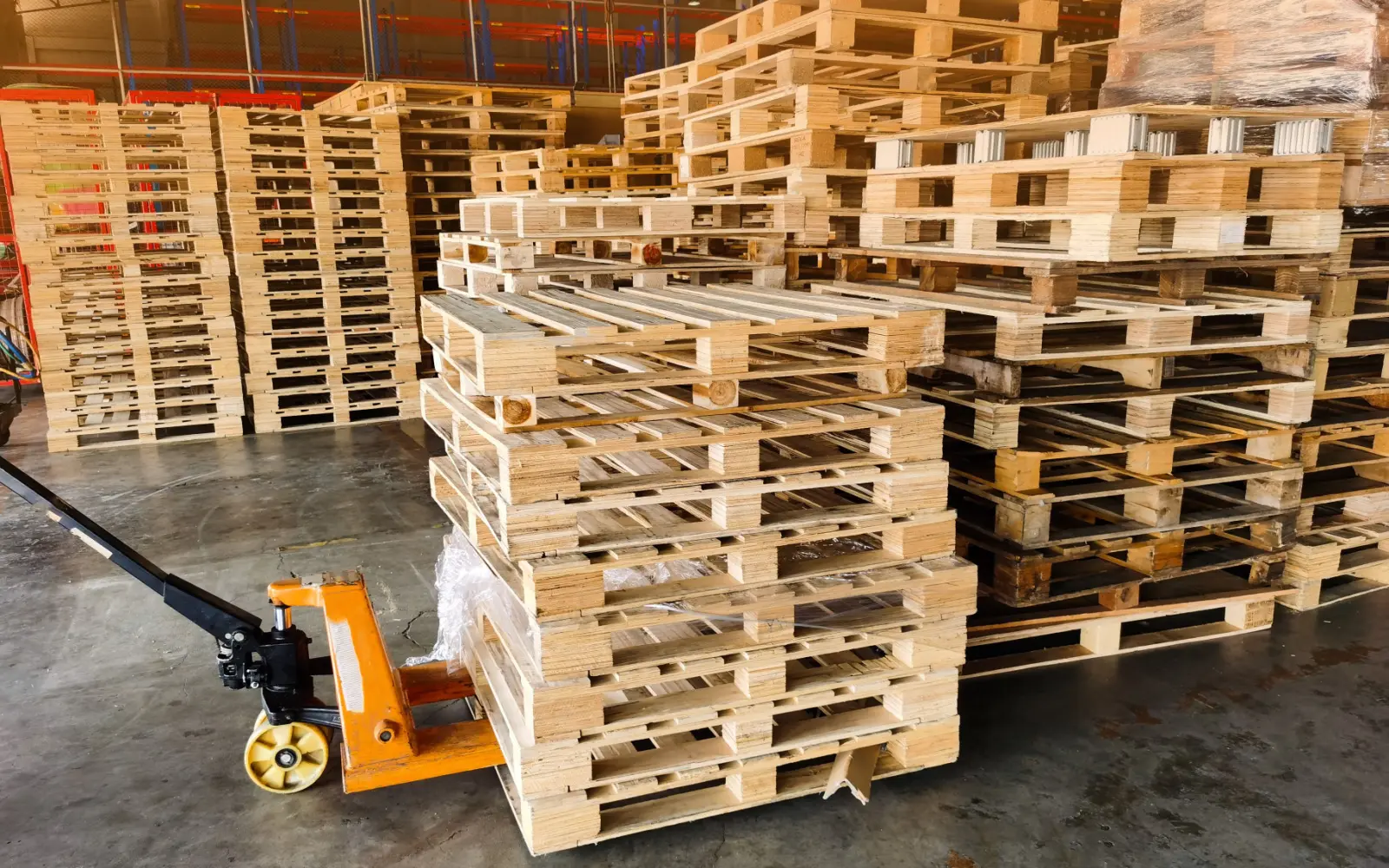Wooden pallet dimensions are almost always standard. Each size has a specific role in the transportation network.
In this article, we will cover everything you need to know about different wooden pallet dimensions and what different dimensions mean for different industries.
Wooden Pallet Dimensions: A Summary
The most common sizes for wooden pallets are as follows:
- 48 x 40
- 42 x 42
- 48 x 48
However, some industries have different pallet sizes. Which size you use depends on what industry you work in rather than what you’re shipping.
Wooden Pallet Sizes Across Industries
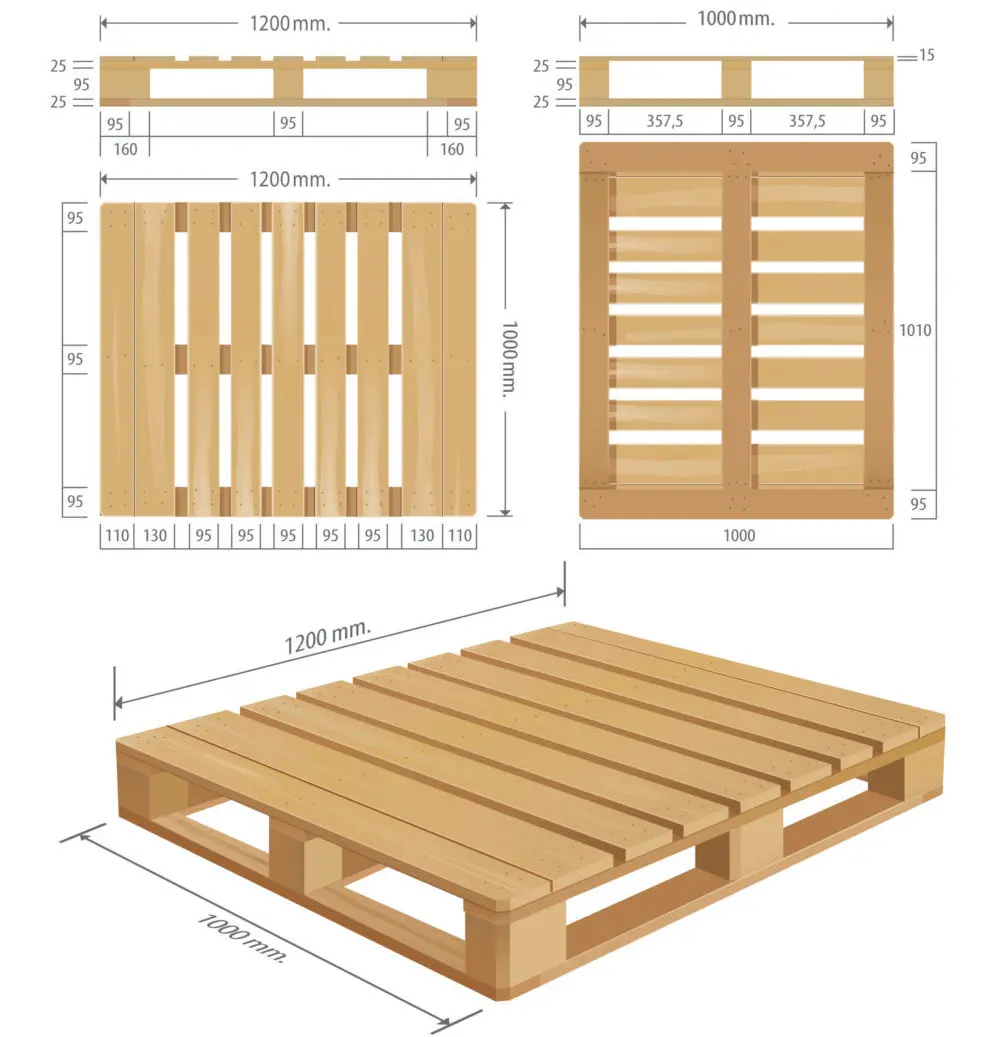
Elgusser/Shutterstock
Here are the main sizes of pallets and their uses.
48 x 40: The GMA Pallet
The standard pallet, also known as the GMA pallet, is the most common in the United States. Originally named for the Grocery Manufacturers
Association, which is now the Consumer Brands Association. GMA pallets are a standardized size and width and a popular choice for general warehousing needs.
This pallet size has several advantages. First, it’s wider than it is deep. It’s easy to display merchandise directly from the pallet this way. Second, it’s easier for people to reach to the back of the pallet to grab items.
The deeper the pallet is, the harder it becomes. GMA pallets are so popular that most food and grocery stores package products to ensure they’ll fit evenly on pallets this size. If you see a pallet in a grocery store, it’s probably a GMA pallet.
42 x 42: Telecom and Paint
The smaller 42 x 42 pallets are most popular with the telecom and painting industries, both of which are rather sizable in their own right. For painting, the cylindrical style of paint cans means they fit best on a square pallet instead of a rectangular one.
They also help deter pallet theft since they aren’t as desirable as GMA pallets. Outside of the size factors, 42 x 42 pallets make it possible to add some padding between each pallet before transport.
You can still fit them in the standard shipping sizes. This padding reduces shaking and gives an extra margin of safety while transporting sensitive electronics.
48 x 48: Drums
Drum pallets are the primary option for carrying standard liquid drums, including those used for oil. Each of these pallets fits four 55-gallon drums. Given how many of those there are, these pallets see a lot of use.
These drums are so iconic that they’re the primary measurement for oil. When people describe production, they don’t measure it in gallons or liters but in how many 55-gallon barrels the oil would fit in.
48 x 20: Special Retail
The special retail pallet is half the size of a GMA pallet. Many stores don’t need an entire pallet of specific items, so halving the size makes it easier to send what a store needs with minimal misuse of space.
These pallets also do well for displays, as they’re short enough that most customers can easily reach across them.
48 x 36: Paper
Paper pallets are a rarer size than average. They exist specifically for transporting heavy loads of printer paper around.
Like tiles, much of this has to do with the paper’s weight. Paper is heavy in concentration. People often need to lift and load it when it’s against a wall.
44 x 56: Canned Goods
Canned goods tend to ship on large pallets. Although not quite as wide as GMA pallets, these are more than a foot deeper and can hold more cans.
The odd size often creates extra room between the pallets when shipping, which allows fitting in padding and ensuring cans don’t jostle around and dent each other.
42 x 31: Tiles
Tile pallets are a relatively rare dimension on the market. Tiles are usually heavy to start with, often made of solid stone or similar materials, so they can quickly approach the weight limit of a standard pallet.
Tiles also tend to be sold straight from their pallet more often than other goods, and customers need to be able to reach and handle them. The result is a pallet with a relatively standard width but a shorter length than most others.
Companies may use the extra space from the non-standard size to add additional packaging and protect the tiles in transport, as many are vulnerable to breaking from impacts.
40 x 48: Dry Goods
Dry goods often ship on an inverted GMA pallet, which is longer than it is wide. These have several advantages for the shipping industry.
First, alternating the orientation makes it possible to achieve better packing density in the same space. Second, these aren’t quite as wide, so they make it easier to display more goods, with more pallets, in store aisles.
48 inches is often too deep for most customers to reach, so stores use tools to pull items forward as the previous ones sell. Replacing the products is as easy as loading in a new pallet, which significantly shortens stocking times and increases store worker efficiency.
40 x 40: Dairy
The dairy industry uses its own pallet size for transportation. 40 x 40 pallets are the ideal size for stacking milk crates, most of which have an internal dimension of 12 x 12 inches, then a little more on the outside to ultimately fit on the 40 x 40 pallet in a square design.
36 x 36: Drinks and Beverages
Non-dairy drinks usually ship on slightly smaller pallets, measuring 36 inches on a side. These can usually fit through doors in grocery stores, which are larger than average, and they also match the smaller bays on drink delivery trucks.
35 x 45.5: Military
The military uses several different pallet sizes as necessary, but the 35 x 45.5 pallet is one of the most common. It’s required when shipping goods within the military.
The military designed this size specifically to fit easily through 36-inch doors, one of the most common door sizes in the world. Fitting through doors makes it much easier to transport goods into and throughout buildings, which can be a significant time-saver in sensitive situations.
Military operations don’t always have the luxury of working in areas built to accommodate wider pallets, so using this as a default simplifies logistics.
Things to Consider About Pallets
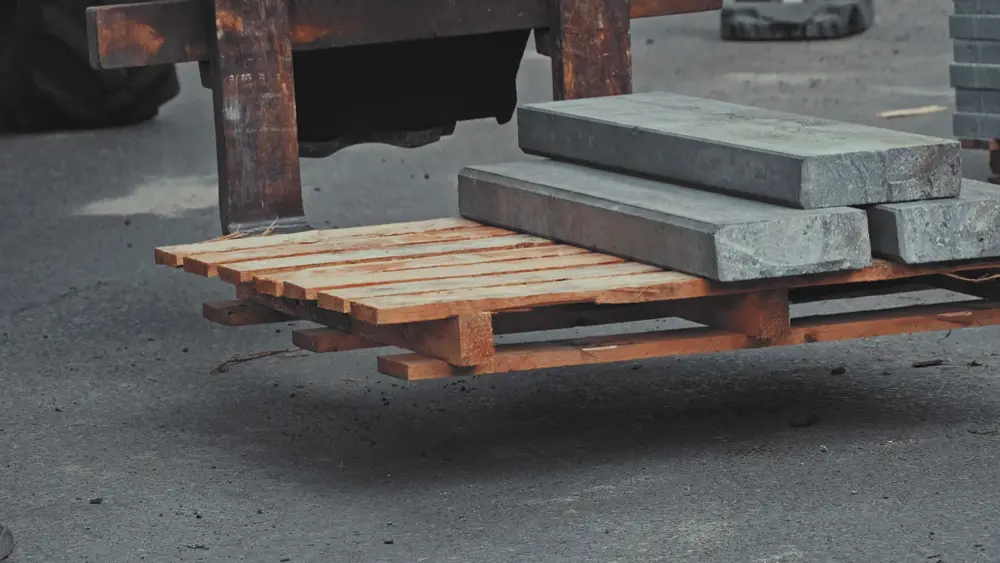
pkajak201/Shutterstock
While some people buy GMA pallets and call it a day, there’s a reason that industries often use their own pallet sizes.
Pallets aren’t equal just because they’re the same size, either. Here are some things to consider before you go shopping for pallets.
Compatibility
Pallets may need to travel with equipment inside vehicles or warehouses. While most pallets can easily support forklifts, they may not have the ideal dimensions to interact with other systems. Some pallets are only accessible on two sides, while others have connections on all four.
Wooden pallet dimensions can end up being a critical component of warehouse management needs, so knowing exactly how the pallets a company uses function is critical to proper warehouse design.
Management Needs
Some pallets are considerably easier to acquire than others. What most buyers need more than anything else is an uninterrupted supply of pallets. If you use the same size for all of your shipping, you can usually accommodate any minor sizing problems.
If you use many different sizes, it becomes much harder to organize and move the pallets around. While some companies manufacture pallets internally, especially for custom needs, most get their pallets from suppliers instead.
Good suppliers can adjust to changing needs, as companies often have sudden surges in demand and may need a lot of extra pallets on short notice.
Number of Uses
Pallets see varying uses. Some only get used once, while others may transport goods multiple times with proper maintenance. Companies like GMR help recycle pallets and ensure components see as much use as possible, which limits wood consumption and helps lower costs for companies.
Time for use is also a consideration. Some pallets may stay in place and hold goods for months at a time. Whether this pallet is indoors or outdoors, the humidity in the area and factors like that can determine whether it will last long enough.
Pallet Destinations
Pallets can travel through different temperatures and environments, especially if they’re going overseas. Aquatic transport can take literally months and may require some exposure to moisture if the products aren’t in an airtight container.
In these cases, wood needs to be heat-treated or chemically treated to help prevent rot, mold, and pests from taking hold. Pallets may also face damage at their destinations. Moving metal components are particularly damaging and include shopping carts hitting pallets within stores.
Weight
Pallets need to hold the weight of all products on them. Wood pallets have an excellent storage capacity and a reasonable price point, but they’re not nearly as durable as well-made plastic pallets.
Some goods are so heavy that it’s not practical to ship more than one of them per pallet, in which case custom pallet sizes may be necessary. Most wooden pallets hold between 3500 and 5000 pounds, depending on their size and condition.
Pallet Materials
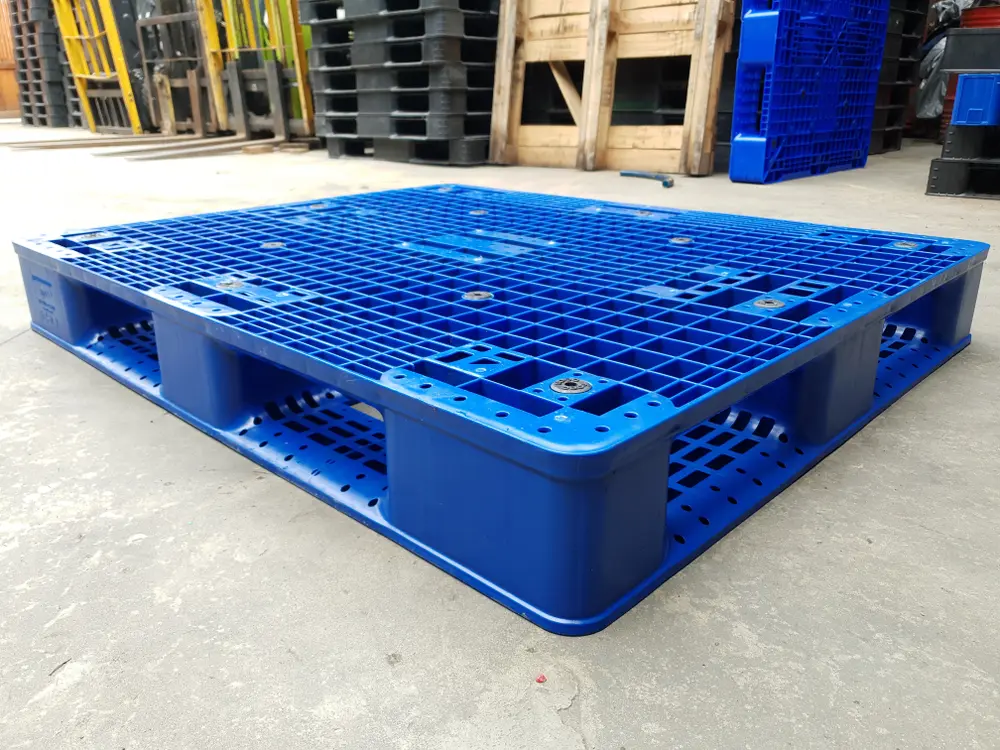
Nguyen Duy Tan/Shutterstock
Most pallets are made from one of four materials. Wood is easily the most common option. It’s cheap, lightweight, easy to customize, and has enough strength to hold heavier items for extended periods.
However, wood can be susceptible to rot, and it’s often a bad choice for transporting food. Plastic pallets can’t hold as much weight as wood. However, they’re more sanitary, which makes them a better option for transporting food around.
Plastic is far more reusable than wood, but it’s also significantly more expensive up front. The reusable nature can make plastic more affordable over time, though. Metal is the heaviest option for pallets, but it’s also the most durable.
These can handle hot or cold weather without difficulty, and metal pallets can also hold heavier loads. Most metal pallets use steel or aluminum, and as long as they’re not too damaged, they’ll last basically forever.
Corrugated paper pallets are surprisingly strong, thanks to modern manufacturing methods. They can’t hold quite as much weight as wood, but they’re affordable and recyclable. These are excellent options for single shipments where the goods get unloaded at the end.
Frequently Asked Questions
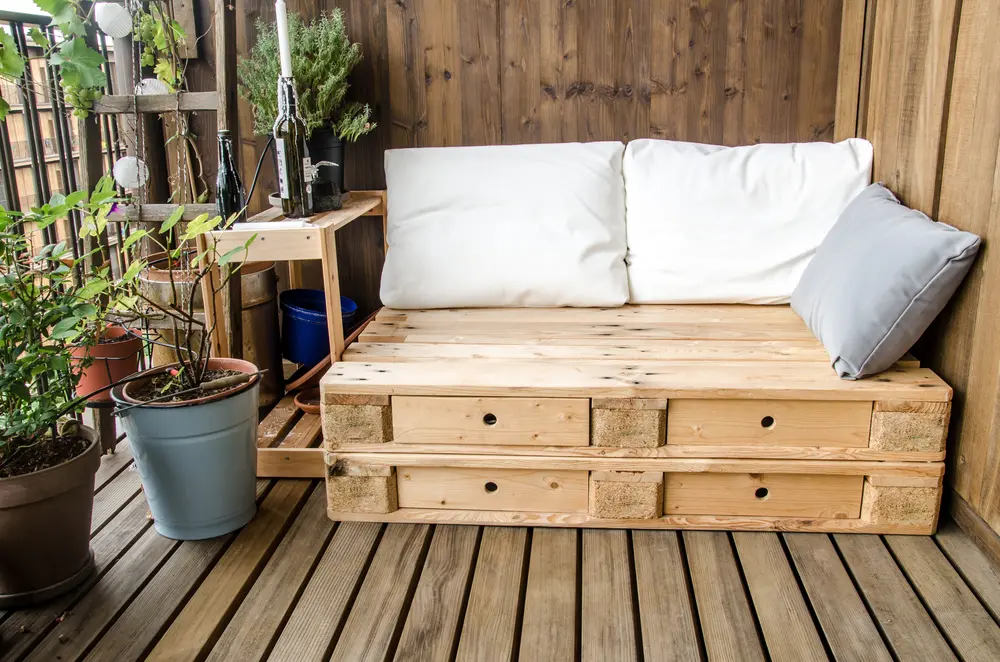
Swissdeone/Shutterstock
Here are some common questions people have about wooden pallet dimensions.
Are wooden pallets expensive?
Wooden pallets usually cost around $12, although this can vary somewhat depending on current market demands.
How tall is the average pallet?
A typical pallet is 6 1/2” tall. Companies try to keep heights relatively standard, regardless of how wide or long the pallets are. This helps simplify pallet transportation.
What is a standard-size pallet?
While standard pallet sizes vary between industries, most people assume you’re talking about a 48 x 40 GMA pallet when you ask about standard sizes.
How high should pallets be stacked?
Pallets can be stacked until they’re about 15 feet high. Any more than this and they start getting difficult to move.
Can pallets be stored on their side?
No, you should not stack pallets on their side. They’re not meant to hold their weight there, and storing them this way can reduce their effectiveness.
So, Why Do Wooden Pallet Dimensions Vary?
Wooden pallet dimensions can vary significantly, but in the end, it’s all driven by industry-specific needs.
If you’re not sure what size pallet to use, look at your needs and what other companies doing similar things have decided, and go from there.

